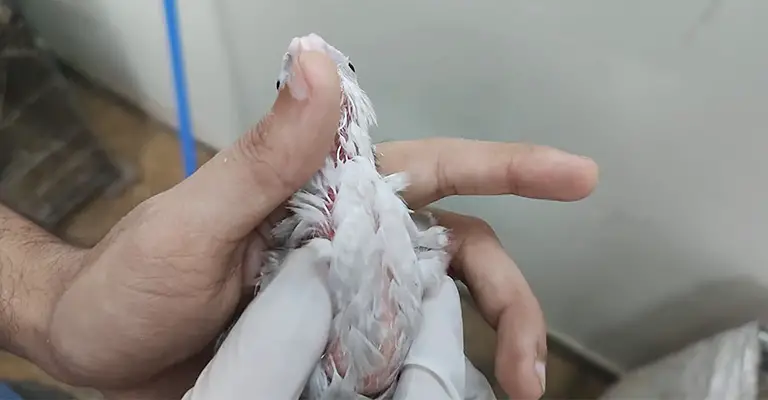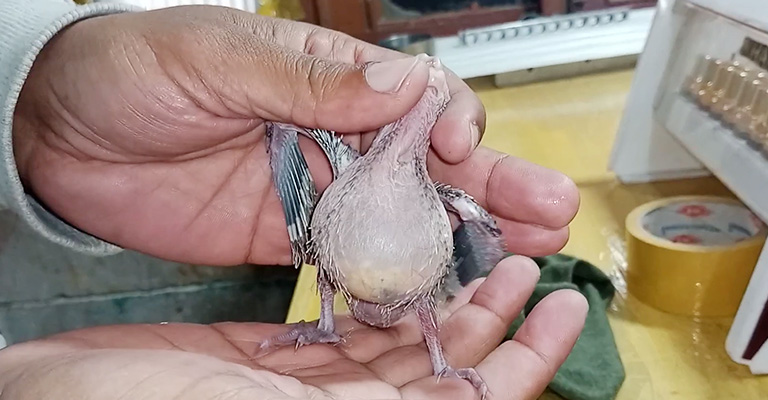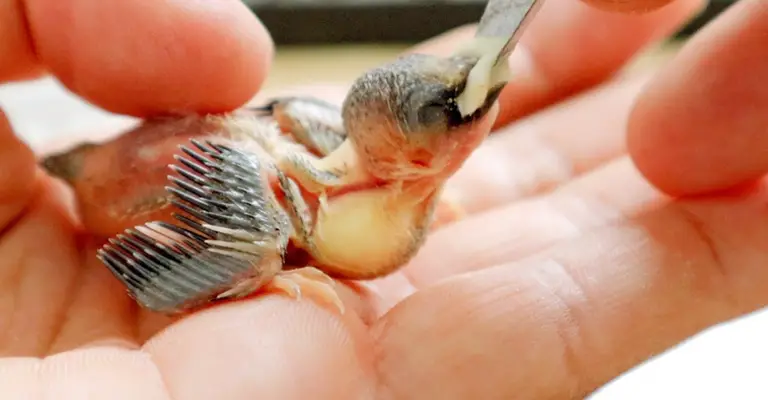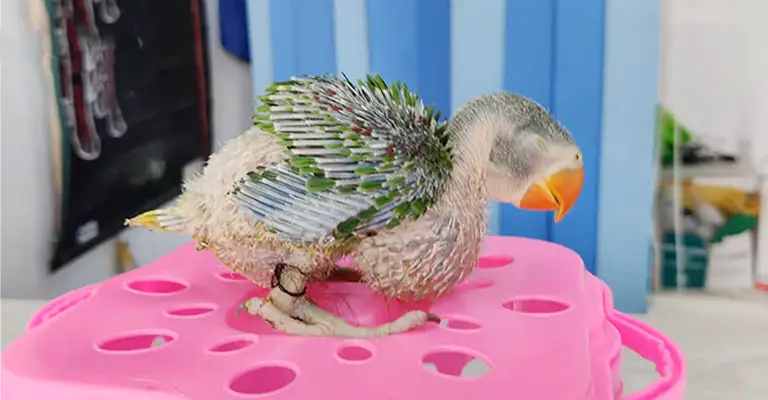Birds have a unique digestive system, including a specialized pouch called the crop. The crop temporarily stores food before it moves into the bird’s stomach for digestion.
In some situations, emptying a bird’s crop becomes necessary, such as when the bird has ingested something toxic or is experiencing crop impaction.
So, how to empty a bird’s crop? First, you can manually empty the crop by massaging it with gentle pressure. You can prepare a saline solution to fluid flush the crop. Another way is to use the gravity method or taking help from an expert vet.
This article will explore four methods to safely empty a bird’s crop and provide step-by-step instructions for each technique.
![How to Empty A Birds Crop? [From Crop to Empty]](https://theworldsrarestbirds.com/wp-content/uploads/2023/06/How-to-Empty-A-Birds-Crop.jpg)
How to Empty A Bird’s Crop?
Here are some points with a broad explanation of how to empty a bird’s crop:
Assess The Situation
Determine if emptying the bird’s crop is essential. Typically, a bird’s crop will empty naturally as it digests food. Intervening to empty the crop manually should only be done in cases of crop impaction, illness, or if specifically instructed by a veterinarian.
Seek Veterinary Guidance
Before attempting to empty a bird’s crop, consult with an avian veterinarian. They can provide specific instructions and guidance based on the bird’s condition and needs. They may recommend bringing the bird in for a professional evaluation and treatment.
Gentle Massage

If advised by a veterinarian, they may instruct you to gently massage the bird’s crop to help facilitate the emptying process. This should be done with great care and using only light pressure to avoid causing harm or discomfort to the bird.
Warm Compress
Applying a warm compress to the bird’s crop area may help stimulate digestion and encourage the crop to empty. Ensure that the compress is not too hot to avoid burning the bird. Again, it is crucial to consult with a veterinarian before attempting this.
Monitor the Bird
After attempting to empty the crop, observe the bird’s behavior and overall condition closely. Seek immediate veterinary assistance if there are any signs of distress, pain, or worsening symptoms.
It’s important to note that the crop is a specialized pouch in a bird’s esophagus that stores and moistens food before it moves to the stomach for digestion.
Manipulating or emptying the crop should only be done under professional guidance, as it can be potentially risky and may cause harm to the bird if done incorrectly.
When to Consider Emptying A Bird’s Crop?

Typically, crops are emptied when a bird’s crop becomes impacted or overfilled with food. The crop is a specialized pouch at the base of a bird’s neck, where food is stored before digestion.
If you suspect a bird’s crop is impacted or overly distended, addressing the issue promptly is essential to avoid complications. Here are some situations when you should consider emptying a bird’s crop:
Crop Stasis
Crop stasis occurs when the muscles in the crop are not effectively moving food through the digestive system. This can lead to a backlog of food in the crop, causing it to become impacted.
If a bird shows symptoms of crop stasis, such as regurgitation, a visibly distended crop, or loss of appetite, crop emptying may be necessary.
Crop Impaction
Sometimes, a bird may consume something lodged in the crop, obstructing the passage of food. If the bird cannot pass the obstruction naturally, crop emptying might be required to remove the foreign object.
Crop Infection
The crop can sometimes become infected, leading to inflammation and swelling. Manual evacuation might be necessary if the infection causes a blockage or inhibits the bird’s ability to empty its crop naturally.
How To Massage Bird Crops?

Massaging a bird’s crop should only be done under the guidance and instruction of an avian veterinarian. However, if you find yourself in a situation where you need to massage a bird’s crop under professional guidance, here are some broad points to consider:
Positioning
Ensure that the bird is calm and comfortable. Having another person gently restrain the bird to keep it still during the massage may be helpful.
Locate the Crop
The crop is a bulge in the bird’s upper chest area, just below the neck. It can vary in size depending on whether the bird has recently eaten or is digesting food.
Use Gentle Pressure
Using only light pressure and delicate movements, softly massage the crop in a circular or gentle kneading motion. Avoid applying excessive force, as the crop is delicate and easily damaged.
Observe the Bird’s Response
Monitor the bird’s behavior and reactions during the massage. Stop immediately if the bird shows discomfort, pain, or distress, and seek professional veterinary advice.
Be Cautious and Gentle
The crop is a sensitive area, so it is crucial to be cautious and gentle during the massage. It is always better to err on the side of caution and seek professional help if you are unsure or uncomfortable performing the massage yourself.
Remember, massaging a bird’s crop should only be done under veterinary supervision and if a specific need or medical condition requires it. It is always best to consult an avian veterinarian who can provide appropriate guidance and ensure the bird’s well-being.
What are some Bird crop infection symptoms?

Symptoms of a bird crop infection can vary depending on the specific infection and severity. However, here are some common symptoms to look out for:
Crop Swelling
The crop may appear swollen or enlarged compared to its standard size. This can be visually noticeable or felt when gently palpating the bird’s crop.
Reduced Appetite
Birds with a crop infection may show a decreased interest in food or have difficulty eating. They may exhibit reluctance to eat or show signs of discomfort while swallowing.
Regurgitation Or Vomiting
Birds with a crop infection may regurgitate undigested or partially digested food. This can be observed as the bird bringing up food from the crop and expelling it from its beak.
Foul Odor
An infected crop can produce a foul smell. If you notice an unpleasant odor coming from the bird’s mouth or crop area, it may indicate a crop infection.
Discharge Or Abnormal Material
Occasionally, a discharge may be present around the bird’s beak or in the crop area. This can include pus, mucus, or abnormal contents in the crop, such as undigested food or fluids.
Weight Loss And Weakness
A bird with a crop infection may experience weight loss and overall weakness. They may appear lethargic, have a decreased activity level, and show signs of reduced stamina.
Changes In Droppings
The bird’s droppings may be abnormal, such as changes in color, consistency, or frequency. This can be an indication of digestive disturbances associated with the crop infection.
Behavioral Changes
Birds with a crop infection may display changes in behavior, such as increased irritability, depression, or decreased interaction with their environment or caretakers.
FAQs
Birds do not have a vomiting reflex, so inducing vomiting is ineffective for emptying a bird’s crop.
Signs of a crop impaction may include regurgitation, a distended or hardened crop, decreased appetite, and overall lethargy. It is essential to seek professional help if you suspect crop impaction.
Force-feeding a bird can be dangerous and should only be done under the guidance of an experienced avian veterinarian.
After emptying a bird’s crop, ensure it is adequately hydrated and monitor its condition closely. If any concerns arise, consult a veterinarian promptly.
Bottom Line
That was all about how to empty a bird’s crop. Emptying a bird’s crop should be cautiously approached and performed only when necessary.
The methods described above provide different approaches to safely emptying a bird’s crop, ensuring the bird’s well-being.
It is important to remember that some situations may require professional assistance, so consulting an avian veterinarian or a wildlife rehabilitator is crucial for the bird’s optimal care.